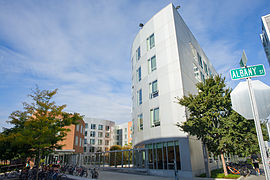Housing at the Massachusetts Institute of Technology
This article needs to be updated. (May 2023) |
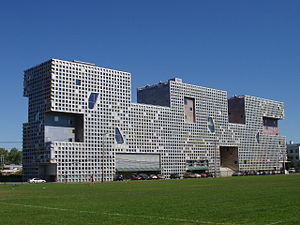
At the Massachusetts Institute of Technology (MIT), students are housed in eleven undergraduate dorms and nine graduate dorms. All undergraduate students are required to live in an MIT residence during their first year of study. Undergraduate dorms are usually divided into suites or floors, and usually have Graduate Resident Assistants (GRA), graduate students living among the undergraduates who help support student morale and social activities.[1] Many MIT undergraduate dorms are known for their distinctive student cultures and traditions.
Both undergraduate and graduate dorms have a resident Head of House, usually a member of the MIT faculty, living in a special apartment suite within the building. Some larger dorms have multiple Heads of House, each responsible for a section of the building, who consult together on building-wide issues.
McCormick Hall is a women-only dorm; all other dorms are coeducational. Westgate and the Graduate Tower at Site 4 are designated for graduate student family housing, and all other dorms are reserved for single students.
In addition, a portion of MIT undergraduate upperclassmen live in MIT Fraternities, Sororities, and Independent Living Groups (FSILGs),[2] either on campus or nearby in Cambridge, Boston, or Brookline, Massachusetts.
Overview
[edit]Dormitory cultures
[edit]Over the years, MIT undergrad dormitories have developed a diverse range of cultures and traditions. With occasional local exceptions, the West Campus dorms (Maseeh, McCormick, Baker, Burton-Conner, MacGregor, New House, Next House, Simmons, New Vassar) have tended to be more mainstream in their outlook, while the East Side dorms (East Campus, Senior House, Random, Bexley) have been the home of many different subcultures, such as LGBTQ, Goth, counterculture, and anarchist.[3] Since 2002, MIT has required all first-year undergrads to reside in dormitories, partly to control irresponsible abuse of alcohol in some fraternities, which had resulted in the death of a freshman.[4] Since then, the total undergraduate enrollment at MIT has been partially constrained by the number of dormitory spaces available.[5]
There are also specialized subgroups of students within some of the larger dormitories, usually based on shared interests, language, or culture. Examples include French House, German House, La Casa, Chocolate City, Juniper, and iHouse.[6]
Upon arrival, first-year students are temporarily assigned to on-campus dormitory housing, based on a preliminary application and a lottery.[7] They occupy this room as a homebase while they participate in Orientation and Residence Exploration (REX, also informally called "Dorm Rush") week, when the upper-class residents of various dorms offer special events to highlight their individual cultures and amenities.[7] Students who wish to switch residences apply for the First Year Residence Exchange (FYRE) program, subject to availability of spaces.[7] If they cannot move immediately, they can apply to move at the start of the next semester.[7]
In years when there is a shortage of undergrad housing (historically caused by scheduled major renovations, unexpected building system failures, or unanticipated peaks in admissions yield rates), a "temporary overflow housing" program is declared. Extra spaces are found by measures such as placing more students in rooms, using suite lounge spaces, renting hotel rooms, and other temporary expedients.[8][9]
"New Vassar", a 450-bed undergrad dormitory at 189 Vassar Street (Building W46), was completed in the fall of 2020 and opened for students in the spring semester of 2021.[10]
Design goals
[edit]In 2016, the MIT administration published its guidelines for design of new and renovation of older undergraduate dormitories.[11] An ideal size of 350 students per dormitory, organized into "clusters" of 30 students was proposed, consisting of 30-40% singles and the remainder double-occupancy rooms. Each room is to be equipped with furniture made of durable oak wood, designed to be modular and somewhat reconfigurable by the residents. Three bathrooms (allowing flexible gender designation) would be shared by each cluster of rooms, equipped with shared sinks and individually enclosed toilets and showers.[11]
The report viewed shared cooking and dining facilities as essential parts of MIT student life and education. Some dorms would contain dining halls, and others would be designated as "cook-for-yourself" residences. Both types would also have some accommodations for larger group dining and individual or group cooking, including large "country kitchens" for groups of students working together. Informal and formal teaching about diet and cooking would be encouraged, in response to the expressed interest of many MIT students in learning how to cook. Dining halls would be structured for ease of access by other members of the MIT community, including students, faculty, and staff not residing in the host dorm, to facilitate wider social interactions and events.[11]
The guidelines say that a number of rooms and facilities should be shared dorm-wide, such as spaces for music rehearsal, games, media viewing, studying, exercising, meeting, and other individual or group activities. Makerspaces are increasingly emphasized to support MIT's founding Mens et Manus ("Mind and Hand") ethos and participation in the arts and athletics. A large enclosed exterior space or courtyard should be provided, gated for security while permitting wider community access for special occasions, and protected from solar glare and excessive wind.[11]
The guidelines also state that dormitories should be designed to qualify for LEED gold certification, including central air conditioning to discourage improvised window air conditioner installations and to enable year-round use of the buildings.[11] The new Vassar Street dormitory (Building W46) was specifically designed with these guidelines in mind.[10]
Dining options
[edit]The MIT administration has emphasized incorporation of shared dining facilities into several larger undergraduate dormitories, as places where daily informal social interactions can occur. After discontinuation of "mandatory commons" dining in 1970, MIT continued to operate dining halls in several dormitories on an opt-in meal plan basis. Required meal plans were reinstituted in fall 2011 for residents of several dormitories, despite the vigorous objections of some students.[12][13][14] As of 2023[update], the MIT meal plans offer a mix of choices, required for residents of some dorms, and optional for all other undergraduates and all grad students.[15]
As of 2023[update], the mandatory meal plan dorms are:[15]
- Baker House
- Maseeh Hall (the only meal plan hall which is also open for lunch)
- McCormick Hall
- New Vassar
- Next House
- Simmons Hall
The other dorms are designated as "cook-for-yourself" communities, and have kitchens on each floor, or in each suite of apartments. Residents of these dorms may also opt to sign up for a meal plan at another dorm with dining facilities, or may eat at any dining hall on a "cash" basis. Free shuttle service is available to selected grocery stores off campus and there is a fresh produce market on campus open one day per week throughout most of the calendar year.[16]
Undergraduate dorms
[edit]Baker House
[edit]

Baker House,[17] located at 362 Memorial Drive, is a co-ed dormitory at MIT designed by the Finnish architect Alvar Aalto in 1947–1948 and built in 1949. Its distinctive design has an undulating shape which allows most rooms a view of the Charles River, and the dining hall features a "moon garden" roof. Aalto also designed custom furniture for the building's rooms, many of which are wedge-shaped. Baker House was renovated for its fiftieth anniversary in 1999, modernizing the plumbing, telecommunications, and electrical systems and removing some of the interior changes made over the years that were not in Aalto's original design. Baker House celebrated its 75th Anniversary in 2024 with over 382 house alumni in attendance.
The dorm was named after Everett Moore Baker, an MIT Dean of Students, who died in a plane crash in Egypt in 1949.[18][19] The dormitory houses 318 undergraduates in single, double, triple, and quadruple rooms.
A Baker House tradition involves dropping an old worn-out piano from the roof. Started by former Baker resident Charles Bruno in 1972, the piano is dropped on Drop Day—the last day MIT students can drop a class with no penalty.[20]
Notable Baker House alumni include Kenneth Olsen (Electrical Engineering, 1950), co-founder of Digital Equipment Corporation; Amar Bose (Electrical Engineering, 1951), founder of the Bose Corporation and inventor of numerous audio technologies; Alan Guth (Physics, 1968), astrophysicist and professor of physics at MIT; Timothy Carney (1966), former US Ambassador to Sudan and Haiti; Gerald Sussman (Mathematics, 1968), professor of computer science at MIT; Geoffrey A. Landis (Physics and Electrical Engineering, 1980), NASA scientist and science fiction writer; Ronald T. Raines (Chemistry and Biology, 1980), professor of chemistry at MIT; Cady Coleman (Chemistry, 1983), NASA Astronaut; Wes Bush (1983), former chairman and CEO, Northrop Grumman; Warren Madden (1985), Weather Channel meteorologist; Jonathan Gruber (Economics, 1987), healthcare economist and political advisor; Charles Korsmo (Physics, 2000), actor in movies such as Hook and Can't Hardly Wait; Ed Miller (Physics and Electrical Engineering, 2000), noted poker authority; and Katy Croff Bell (Ocean Engineering, 2000), National Geographic ocean explorer.
Burton-Conner House
[edit]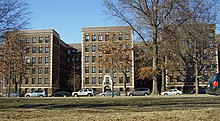
Burton-Conner House,[21] (shortened to Burton-Conner or BC), is located at 410 Memorial Drive, on the north bank of the Charles River. Burton-Conner houses 344 residents. The building is five stories high, plus a ground floor.
Burton-Conner is a combination of two major sections of the former "Riverside" hotel and apartment building, which MIT acquired and reopened as a dormitory in 1950. "Burton House" consists of the 3 westernmost wings, while "Conner Hall" comprises the remaining 2 wings of the extended E-shaped structure. Burton is named after former dean Alfred Edgar Burton.[22] The two sections of the building are physically separated by a firewall above the ground floor, with five residential floors on the Burton side and four on the Conner side.
In the 1960s, a dining hall was added at the rear of Burton-Conner, on the side away from the river. Some years later, the dining hall was shut down and the space became the Porter Room, a shared meeting and student event space.[23] The entire building underwent a complete restructuring during 1970–1971, when the internal layout was changed from a floor orientation (with floor-wide bathrooms and communal showers) to a suite orientation (introducing kitchens, suite lounges, and semi-private bathrooms). Today, Burton-Conner amenities include a library with Athena-network computers, a study area, an electronics lab and darkroom (unused for over 10 years), music rooms, a game room, weight and exercise rooms, and a lounge with a snack bar.[needs update]
In February 2019, the MIT administration announced that Burton-Conner would be closed from June 2020 to August 2022 for a complete renovation.[24] Dorm residents expressed concerns about interim housing and the effects this might have on dorm culture.[25] The dorm was re-opened during the wind-down of the COVID-19 pandemic in September 2022, amid criticism that the building was "without landmarks" due to restrictions on students painting traditional wall murals.[26] Canvas panels were offered instead, but the paperwork, approvals needed, and delays were objected to.[26]
East Campus
[edit]

Variously known as East Campus, East Campus Alumni Memorial Houses, and Fred the Dorm,[27] East Campus is MIT's second oldest dormitory after Senior House. Located at 3 Ames Street, it is an undergraduate dorm formed from six "houses", each named after an alumnus of MIT:
- Goodale (Charles W. Goodale, 1875)
- Bemis (Albert Farwell Bemis, 1893, member of the MIT Corporation from 1914 to 1936)
- Walcott (William W. Walcott, 1901)
- Munroe (James P. Munroe, 1882, Secretary of the MIT Corporation from 1907 to 1929)
- Hayden (Charles Hayden, 1890, member of the MIT Corporation from 1907 to 1929)
- Wood (Kenneth F. Wood, 1894)
East Campus is arranged in two long north–south buildings, the East Parallel (one house built in 1924, extended to full parallel in 1928) and the West Parallel (built in 1931). The buildings are numbered 64 and 62, respectively, in MIT's building numbering system.[28] There are 5 floors, plus a non-residential basement, in each building. The three "houses" that make up a building are connected on each floor, functioning as one contiguous building. The two building basements are connected via a tunnel.
The dorm celebrated its 90th anniversary in 2014. Due to the dorm's age, sturdiness, and tradition, the 350-400 undergrads living there are allowed to paint and alter rooms and floor common spaces, up to the limits of what the Cambridge fire code will allow. Students frequently use technology to customize their rooms, building projects such as an Emergency Pizza Button to have a local pizza shop deliver a cheese pizza,[29] a disco dance floor,[30] and an automatic door-unlocking system.[31]
The social life of East Campus residents includes ambitious build projects (such as a 130-foot (40 m) roller coaster[32]) during REX Rush Week, Bad Ideas Weekend during January,[33] and various feasts and celebrations, generally located in the courtyard between the two parallels. Participants in such events have traditionally included some residents of nearby Senior House (before the undergraduate residents living there were disbanded), and continue to invite alumni of both residences to join in planning and attendance.
Notable alumni of East Campus include Ahmed Chalabi (Mathematics, 1965) of the Iraqi National Congress; George Smoot (Mathematics and Physics, 1966), co-recipient of the 2006 Nobel Prize in Physics; Jacob K. White (Electrical Engineering and Computer Science, 1980), MIT professor and IEEE Fellow; Michael Fincke (Aeronautics and Astronautics, 1989, and Earth, Atmospheric, and Planetary Sciences, 1989), NASA astronaut; Thomas Massie (Electrical Engineering, 1993), US Representative for Kentucky, Arash Ferdowsi (no degree, 2008) co-founder of Dropbox, and Sam Bankman-Fried (Physics, 2014), founder of the cryptocurrency trading firm Alameda Research and the FTX cryptocurrency exchange.
The dormitory is closed for two years beginning in June 2023 for a complete gut renovation. The renewed buildings will be completely air-conditioned, fully ADA-accessible, and include new amenities in common areas.[34](registration required) During the closure, East Campus residents will be housed in other dormitories, hotel rooms, and the building formerly occupied by an on-campus fraternity which has been disbanded.[34](registration required)
MacGregor House
[edit]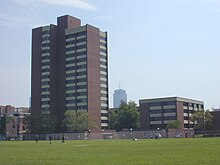
MacGregor House,[35] located at 450 Memorial Drive, was designed by Pietro Belluschi, built in 1970, and named for Frank S. MacGregor (SB 1907, Physics).[36] It consists of a 16-story high-rise tower, connected to a four-story low-rise surrounding a paved courtyard. Both parts consist of suites grouped into "entries" of three to four floors each. The entries are named by letter: A, B, C, D, and E entries are located in the tower and F, G, H, and J entries are located in the low-rise. There is no I-entry, because i is imaginary.[37] The ground floor consists mostly of dorm-wide common areas.
Each suite in MacGregor houses six to eight people, usually coed; the entire dorm houses 326 undergrads. Almost all rooms in MacGregor are singles; the three doubles in F entry are an architectural anomaly. Each suite comes equipped with a bathroom and a kitchen area with a 4-burner electric range-top; in addition, one suite in an entry also has an oven.[37]
MacGregor features various amenities, including a music room, game room, and weight room. A convenience store (MacCon) was located inside MacGregor on the first floor, but closed in 2017.[37]
The building and its surroundings are well known on campus for fierce winds and gusts during stormy weather. A computational fluid dynamics (CFD) study examined the causes of this phenomenon in detail, but did not propose any specific measures to ameliorate it.[38]
Maseeh Hall
[edit]
Maseeh Hall[39] is located at 305 Memorial Drive, at the intersection of Memorial Drive and Massachusetts Avenue, across the Avenue from MIT's Building 1. The building itself predates MIT's move to Cambridge in 1916. It was originally operated as the "Riverbank Court Hotel" from 1901 to 1937. In 1938, MIT reopened it as "Graduate House", later renaming it "Ashdown House" after its first faculty housemaster, Avery Allen Ashdown.[40] By the beginning of the 21st century, the building had become run-down and in need of renovation. Graduate students were moved out, to a new Ashdown House (NW35) located much further away, a controversial decision justified by a desire to house all undergrads as close as possible to MIT's central campus.[41][42] The exterior of the emptied building was immediately repaired to stop water leaks and further deterioration, but there was no funding to renovate the interior of the structure.
In 2010, Fariborz Maseeh (ScD 1990, Civil Engineering) donated $24 million for the purpose of increasing MIT's undergraduate enrollment by 270 students (an increase of 6%).[5][43] To enable this, the number of undergraduate dormitory beds needed to be increased, since MIT now requires all undergraduate students to live in dormitories on campus for at least their first year. Fariborz Maseeh's donation was used to renovate the building, and the building now bears his name.
Maseeh Hall was first opened to undergrad residents in August 2011.[44] Upon its re-opening, Maseeh Hall was MIT's largest undergrad dorm with 462 beds; in 2013, the building's occupancy was further increased to 490.
The lobby of Maseeh Hall is architecturally notable for its spacious vaulting and mosaic decorations made of Guastavino tile.
McCormick Hall
[edit]
McCormick Hall,[45] located at 320 Memorial Drive, is a women-only dormitory housing 237 undergrads. It consists of two 8-floor towers (the east tower and the west tower) and an annex converted from two adjacent brownstone buildings. The three sections are connected on the ground floor. Each tower has a penthouse on the top floor that looks out on the Boston skyline. The east tower has only singles while the west tower has singles, doubles, and triples. The funds for building McCormick Hall came from Katharine Dexter McCormick (SB 1904, Biology), a leading biologist, suffragist, and philanthropist in the early twentieth century.[46] McCormick Hall was designed to advocate and encourage female participation in the field of STEM, supporting gender equality in the former US educational system.[47]
Herbert Beckwith, a faculty of the MIT architecture department, was the designer of McCormick Hall. The west tower was first built in 1963 and the east tower was built later in 1967.[47]
New House
[edit]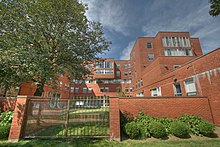
New House,[48] sometimes referred to as New West Campus Houses, houses 291 undergraduates at 471–476 Memorial Drive. The dormitory is a series of six joined five-story buildings arranged in a zig-zag fashion, each named after alumni. There are kitchens and common areas scattered throughout the dormitory. There is a tunnel connecting New House and neighboring MacGregor House.
New House was constructed in 1975 and holds nine separate living groups. From 2017 to 2018, New House underwent an extensive renovation to upgrade infrastructure and improve quality of life. The renovation improved accessibility, enhanced environmental sustainability, and brought in new amenities.[49][50] New features of the renovated dorm included an arcade, an improved first-floor lounge, and interconnected corridors on upper floors.[51]
However, residents lamented the significant impact on student communities that resulted from the renovation project. Students noted that the "pre-existing culture of New House...has largely been lost", pointing to the stress of having to frequently move between temporary housing buildings and the difficulty of rebuilding communities in such circumstances.[51] The renovation destroyed historical murals painted by former students, further contributing to the sense of a loss of culture and tradition.[51]
New Vassar
[edit]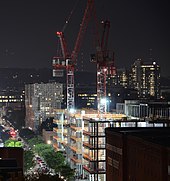
New Vassar[52] (W46) is the newest completed dormitory, opened for the first time in spring semester 2021, accommodating 450 students.
The building is located at 189 Vassar Street, the site of a former parking facility named West Garage.[10] The dorm was approved in December 2017, and construction commenced with the demolition of the garage in January 2018.[53] On February 28, 2019, an accident at the construction site killed one worker and injured two others. Evidence suggests that a material collapse from an upper floor fell down on top of the three workers.[54][55]
MIT portrays New Vassar as a "living-learning community" that helps students grow both academically and personally.[56] Dorm amenities, including a dining hall, a communal kitchen, a courtyard, a makerspace, and group study lounges, were chosen to promote social engagement.[56] The building's design also prioritized environmental sustainability, targeting a LEED Gold certification.[57]
However, MIT students have criticized the design process for New Vassar as "a history of broken promises", with valuable student feedback "destroyed by top-down administrative backtracking".[58] Early in the design stage for New Vassar, MIT administrators sought student input to articulate a set of guiding principles for future dorms, making mutually acceptable compromise between student well-being and administrative needs. Later, administrators unilaterally reversed several decisions without student approval. The incident drew heavy criticism of MIT's leadership and decision-making process, with extensive student feedback and cooperation regularly being overturned with "vague appeals" to statistical data.[58][59]
Next House
[edit]
Next House,[60] located at 500 Memorial Drive, is five stories tall and houses about 350 people. Patterned after the success of Baker House, it opened in September 1981. The "Next House" designation was unofficial and thought to be temporary until a sufficient donation had been received to name the dorm. As a result, the institute has nearly always referred to the building as 500 Memorial Drive, while students have always called the dorm "Next House".
The first level is home to the Tastefully Furnished Lounge (TFL), along with music practice rooms, Next Dining (open daily to all MIT students for breakfast and dinner), Athena computing cluster, and workout rooms. The TFL was so named at the first Next House governance meeting, the words "Tastefully Furnished Lounge" originally appeared in an official brochure distributed at the dedication ceremonies for MacGregor House, and were ironically adopted because the space was initially barely furnished at all. The Next House basement level offers a laundry room, game area, and the Country Kitchen.
Random Hall
[edit]
Random Hall[61] located at 290 Massachusetts Avenue, was created by the joining of two old, identical buildings, a process known to some residents as "siamization". It is the oldest building owned by MIT, and lacks elevators. Originally built in 1894, the building was converted to a visiting students and overflow dormitory in 1968. In the spring and summer of 1977, it was quickly remodeled for undergraduate use to accommodate the unexpectedly large matriculation of the Class of 1981.
Random Hall is the smallest of the MIT dorms, housing only about 93 undergraduates. Its location is also unique among undergraduate dorms, being about a block past the northern border of the main campus. Random Hall was known for its early implementation of bathroom[62] and laundry machine[63] online servers, which allowed people to determine remotely whether bathrooms and washers or dryers are in use.
Random Hall was the home of The Milk, a 30-year-old carton of rancid milk. The carton was originally purchased by Justin O. Cave '98 in 1994 for the purpose of making macaroni and cheese. After forgetting to consume it, residents of Random Hall rediscovered it ten months after its expiration date. The incident gave rise to several activities and celebrations regarding The Milk, including birthday parties, awards for the "Ugliest Manifestation on Campus", and a joke application for admission to MIT.[64][65][66] The Milk was declared missing on August 20, 2022, and has yet to be found.[67]
Simmons Hall
[edit]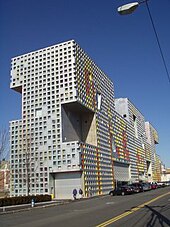
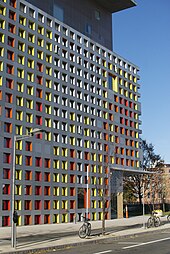
Simmons Hall[68] located at 229 Vassar Street, was designed by architect Steven Holl and dedicated in 2002.[69] At the cost of $78.5 million, it is MIT's most expensive dormitory built on campus since Baker House.
The building is 382 feet (116 m) long and 10 stories tall, housing 344 undergraduate students. The structure is a large reinforced concrete block, perforated with approximately 5,500 square windows each measuring 2 feet (0.61 m) on a side, plus additional larger and irregularly shaped windows. An average single room has nine windows, each with its own small curtain.[70] Internal design consists of one- and two-person rooms, plus lounges with and without kitchens. Rooms are roughly arranged into three towers (the "A", "B", and "C" towers). Simmons Hall has a dining hall and a late-night cafe. The building also has some more esoteric facilities, such as a large ball pit, an electronics makerspace, and a woodworking shop.
Many of the residents of Simmons complain that aesthetics came as a higher priority than functionality.[71] For example, residents in the "A" tower must take two different elevators, or must walk the length of the building twice (more than an eighth of a mile) to reach the dining hall. Neither the "A" elevator nor "A" tower staircases reach the first floor, where the dining hall is located. Dormitory rooms are also equipped with custom-designed, modular furniture made of plywood. These furnishings usually have holes in them or are in the shape of cubes. Student opinions on the furnishings are mixed, with praise for their modularity and criticism for their excessive weight and lack of durability.[72]
The building has been nicknamed "The Sponge", because the architect consciously modeled its shape and internal structure on a sea sponge.[69][71][72] Opinions on the aesthetics of the building remain strongly divided. Simmons Hall won the 2003 American Institute of Architects Honor Award for Architecture, and the 2004 Harleston Parker Medal, administered by the Boston Society of Architects and awarded to the "most beautiful piece of architecture building, monument or structure" in the Boston area. Simmons Hall was featured in the exhibit Inside the Sponge—Students Take on MIT Simmons Hall at the Canadian Centre for Architecture in Montreal in the fall of 2006.[73][74] On the other hand, the building has been criticized as being ugly,[75] a sentiment echoed in James Kunstler's Eyesore of the Month catalog.[76]
Within the building is a sculpture commissioned by American artist Dan Graham. Titled the Yin Yang Pavilion, it consists of a partially reflective, glass-walled, gravel-paved area in the shape of half of the yin-yang symbol in plan, while the other half contains a shallow pool of water.[77]
Former undergraduate dorms
[edit]Some notable MIT undergraduate dorms have been closed down after an extensive operating history. Bexley Hall was demolished due to concerns about structural integrity. Senior House was disbanded, with the building converted to a graduate student residence, after administrative controversies.
Bexley Hall
[edit]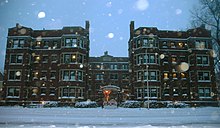
Bexley Hall was a former MIT dormitory located at 46-52 Massachusetts Avenue. Bexley was an early twentieth century brick building, consisting of four four-story walkups surrounding a central courtyard. It was almost directly across the street from MIT's Building 7; old MIT official directories described it as being "just a stone's throw from the Institute's front door".[78] As former apartments which were renovated in the 1970s, Bexley suites had full kitchens and bathrooms. The stout, soundproof walls of Bexley were extensively painted by students and were plastered with murals and graffiti, some of which dated back to the 1960s.
Long known for its alternative culture, Bexley was among the first MIT dormitories to officially become coed, housing 120 undergrads. Some residents owned pet cats and allowed them to roam free around the building, decades before MIT officially adopted a cat-friendly policy in 2008. The May 1970 Grateful Dead concerts at MIT were sponsored by Bexley's housemaster.[79]
Following leads in the phone hacking case of Cap'n Crunch, the Federal Bureau of Investigation visited Bexley in the early 1970s. Twenty to thirty Bexley residents filled a living room and were "interviewed" by two FBI agents. "We shared popcorn, and asked them more questions than they asked us; the spirit was boisterous."[80]
On May 7, 2013, MIT announced that Bexley Hall would be closed for up to three years, due to significant water damage inside the building's exterior walls that rendered the dormitory unsafe to live in.[81] Bexley residents and others expressed considerable concern about the sudden disruption of student housing plans, and possible loss of the unique student culture that had evolved over the years.[82][83][84] On October 17, 2013, MIT's Department of Facilities recommended that Bexley be demolished, deeming it too expensive to repair and bring up to modern building code.[85] As of October 2015[update], the building has been completely removed, and a small park has been established in its place.[86]
Notable alumni of Bexley Hall include U.S. Senator Alex Padilla (D-CA); director of the Vatican Observatory Br. Guy Consolmagno; Dan Bricklin, co-inventor of the computerized spreadsheet; best-selling author and neuroscientist Daniel Levitin; and Jeff Sagarin, a sports computerized ratings guru. Also among former Bexley residents were Institute Professor Jerome Lettvin and his wife Maggie who were Bexley "houseparents" in the 1970s and early 1980s.[87]
Senior House
[edit]
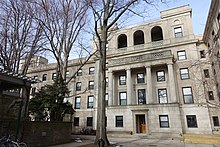
Senior House[88] is the oldest dormitory at MIT and was the first self-governing college dormitory in the United States.[89] Since its construction in 1916, it has served as the institute's first dormitory and on-campus fraternity, a mixed undergraduate and graduate dorm, an all-graduate facility, a seniors' dormitory, and military housing during World War II. The L-shaped building is directly adjacent to the residence of the President of MIT. A tower at the center of the north side features neo-classical columns that reflect the architecture of the original MIT Cambridge campus.
The building's street address is 4 Ames Street, but the mailing address is 70 Amherst Street, because the main entry was moved to what originally was the back of the building. Before implementation of a single-entry building layout, Senior House had six entries named after historical MIT figures:
- Ware (William R. Ware, professor of architecture)
- Atkinson (William P. Atkinson, professor of English language and literature)
- Runkle (John Daniel Runkle, second president of MIT)
- Holman (Silas W. Holman, professor of physics)
- Nichols (William Ripley Nichols, professor of chemistry)
- Crafts (James Crafts, fourth president of MIT).
Citing a low graduation rate and possible drug-related problems in Senior House, MIT administrators implemented a "turnaround program" in 2016 that included the banning of new students and the implementation of changes related to mental health and supervision.[90][91] On June 12, 2017, it was announced that Senior House would be replaced with "Pilot 2021", a program to house mostly first-year students in a more regulated environment.[92] The residence would no longer allow cats, murals, or other elements connected with "East-side" dorm culture. Many members of the East-side MIT community viewed the erasing of Senior House culture as an attack from the administration on their community values.[93][94][95][96][97]
Facing student resistance towards Pilot 2021, MIT announced on July 7, 2017, that the building would be completely emptied of undergraduates and repurposed as a graduate student dorm.[98] This announcement triggered a new round of controversy and discussion among the MIT community.[99][100][101] An article in Wired described the MIT dorm closure as part of a wider trend among American universities of emphasizing safety and orderliness while minimizing legal liability and bad publicity.[102]
Notable alumni of Senior House include
- Patrick Collison (no degree, 2010), co-founder and CEO of Stripe also known for becoming the world's youngest self-made billionaire at age 28;
- Leslie Dewan (Mechanical Engineering and Nuclear Engineering, 2007), co-founder and CEO of Transatomic Power and RadiantNano, former member of the MIT Corporation, named a Young Global Leader by the World Economic Forum.[103]
- Agustin Fierro Rayo (Linguistics & Philosophy, PhD 2001), MIT Professor of Philosophy and Dean of the MIT School of Humanities, Arts, and Social Sciences;
- Br. Robert J. Macke, S.J. (Physics, 1996), Curator of the Vatican Meteorite Collection;
- Deepto Chakrabarty (Physics, 1988), Head of the MIT Department of Physics, awarded the Bruno Rossi Prize for his pioneering work on understanding the exotic environment around fast-spinning neutron stars;
- Aprille Ericsson (Aerospace Engineering, 1986), first Assistant Secretary of Defense for Science and Technology;[104]
- Paula T. Hammond (Chemical Engineering, 1984), MIT Institute Professor and Vice Provost for Faculty, Fellow of the American Academy of Arts and Sciences and all three United States National academies, and a member of the President Biden's Council of Advisors on Science and Technology, known for development of innovative methods to create novel materials one molecular layer at a time and for applying these materials to areas ranging from drug delivery to energy storage;
- Elizabeth Bradley (Electrical Engineering, 1983), applied mathematician, computer scientist and former Olympic rower;
- Barry Nalebuff (Economics and Math, 1980), Yale Professor, co-founder of Honest Tea, business columnist, and author of many books including Thinking Strategically and The Art of Strategy;
- Janos Pasztor (Nuclear Engineering, 1979), a Hungarian diplomat and former Assistant Secretary-General of the United Nations;
- John Brusger (Chemistry, 1978) founder of Newbury Comics;
- Lawrence Summers (Economics, 1975), former president of Harvard University and former Secretary of the Treasury during the Clinton Administration;
- Adrian Bejan (Mechanical Engineering, 1971), eponym of the Bejan number also known for his formulation of constructal theory, which predicts natural design and its evolution in engineering, scientific, and social systems.
- Bruce Morrison (Chemistry, 1965), United States Representative for the 3rd Congressional District of Connecticut, 1983–1991;
- Robert Weinberg (Biology, 1964), Daniel K. Ludwig Professor for Cancer Research at MIT, awarded the National Medal of Science and the Breakthrough Prize in Life Sciences for his contribution to the identification of cellular oncogenes and their role in cancer;
- Clark C. Abt (General Engineering, 1951) founder of Abt Associates also known for first formalizing the concept and usages of serious games;
- Moshe Arens (Mechanical Engineering, 1947), former member of the Israeli Knesset, Minister of Defense, and Ambassador to the United States;
- Gordon S. Brown (Electrical Engineering, 1931), former Dean of Engineering at MIT and a pioneer in the development of automatic-feedback systems and numerically controlled machine tools.
John B. Goodenough, awarded the 2019 Nobel Prize in Chemistry for the development of the lithium-ion battery, was the faculty resident in Senior House when he was part of an interdisciplinary team that developed random access memory. Other notable former Senior House faculty residents include Swiss musicologist, composer, pianist and conductor Ernst Levy and Henry Jenkins, a media researcher and co-founder of the Comparative Media Studies program at MIT.
Graduate dorms
[edit]MIT graduate dorms include the following:[105]
- 70 Amherst Street (E2, formerly undergraduate Senior House)
- Ashdown House (NW35, 235 Albany Street)
- Edgerton House (NW10, 143 Albany Street)
- Graduate Tower at Site 4 (E37, 45 Hayward Street)
- Sidney-Pacific (NW86, 70 Pacific Street)
- Tang Hall (W84, 550 Memorial Drive)
- The Warehouse (NW30, 224 Albany Street)
- Westgate Apartments (W85, 540 Memorial Drive)
-
70 Amherst Street
-
Ashdown House
-
Eastgate Apartments (demolished c. 2022)
-
Edgerton House
-
Site 4 tower construction, July 2019
-
Sidney-Pacific
-
Tang Hall
-
The Warehouse
-
Westgate Apartments
Former graduate dorms
[edit]- The building at 305 Memorial Drive was formerly called "Ashdown House", but has been converted into "Maseeh Hall" for undergraduates. The name "Ashdown House" has been reassigned to the graduate residence at 235 Albany Street.
- Eastgate Apartments (demolished c. 2022)
See also
[edit]References
[edit]- ^ "RL Programs". Residential Life. MIT Division of Student Life. Retrieved 2011-06-18.
- ^ "FSILG". Residential Life. MIT Division of Student Life. Retrieved 2011-06-18.
- ^ Yale Daily News Staff (2009). The Insider's Guide to the Colleges, 2010. St. Martin's Griffin. pp. 377–380. ISBN 978-0-312-57029-3.
- ^ Russell, Jenna (August 25, 2002). "For First Time, MIT Assigns Freshmen to Campus Dorms". The Boston Globe.
- ^ a b Cunniff, Margaret (Sep 10, 2010). "W1 to reopen as Maseeh Hall next fall". The Tech. Retrieved 2023-05-08.
- ^ "First-Year Housing Process". The Guide to Residences. Massachusetts Institute of Technology. Retrieved 2023-05-08.
- ^ a b c d "First Year Residence Exchange (FYRE)". Division of Student Life. Massachusetts Institute of Technology. Retrieved 2023-05-08.
- ^ "How Overflow Housing Works". Division of Student Life. Massachusetts Institute of Technology. Retrieved 2023-05-08.
- ^ Cunniff, Margaret (Sep 10, 2010). "More squeezing in dorms this year". The Tech. Retrieved 2023-05-08.
- ^ a b c "Vassar Street Residence Hall, Building W46". capitalprojects.mit.edu. Massachusetts Institute of Technology. Retrieved 2021-11-29.
- ^ a b c d e "Architectural Principles for MIT Undergraduate Residences" (PDF). Division of Student Life. Massachusetts Institute of Technology. October 14, 2016. Retrieved 2019-06-21.
- ^ Chen, Deborah (November 19, 2010). "More unrest over new dining plan". The Tech. Retrieved 2012-04-12.
- ^ Fan, Jingyun (September 3, 2010). "Final report is released for Fall 2011 dining plan". The Tech. Retrieved 2012-04-12.
- ^ Lloyd, Maggie (February 1, 2011). "Dining ignites campus controversy". The Tech. Retrieved 2012-04-12.
- ^ a b "Meal Plans". Division of Student Life. Massachusetts Institute of Technology. Retrieved 2023-05-07.
- ^ "About Cook-for-Yourself Communities". MIT Campus Dining. MIT. Retrieved 2012-02-24.
- ^ "[Homepage]". Baker House. MIT. Retrieved 2019-04-02.
- ^ Wright, Sarah H. (June 3, 1998). "Baker House dorm getting major renovations". MIT Tech Talk. Retrieved 2011-06-18.
- ^ TWA Flight 903
- ^ Verma, Aditi (2009-04-24). "Annual Baker House Piano Drop Commemorates Spring Drop Date By Aditi Verma The Tech April 24, 2009". Tech.mit.edu. Retrieved 2012-02-29.
- ^ "[Homepage]". Burton Conner. MIT. Retrieved 2019-04-02.
- ^ "For Release in SUNDAY Papers" (PDF). MIT Archives. 1951-06-03.
- ^ "MIT Dorms: Burton Conner House". MIT Admissions. 14 May 2006.
- ^ "Burton Conner Renewal Project (Updated) 2-27-20.pdf" (PDF). Retrieved 11 June 2020.
- ^ Hennacy, Kaitlyn; Anderson, Zoe; Sheill, Zoe (Feb 21, 2019). "Burton Conner residents concerned about dorm renewal". The Tech. Retrieved 2019-06-21.
- ^ a b Wu, Wenbo (Sep 8, 2022). "Burton Conner reopens to residents after renovation". The Tech. Retrieved 2023-05-07.
- ^ "Homepage". East Campus. MIT. Retrieved 2019-04-02.
- ^ "MIT Campus Map (interactive)". MIT Website. MIT. Retrieved 2011-04-19.
- ^ "Innovation is a hallmark of the Institute" MIT News. September 14, 2005. Retrieved November 3, 2014.
- ^ "Disco Dance Floor" MIT TechTV. June 7, 2007. Retrieved November 3, 2014.
- ^ "Top 10 Wired Colleges - #2 M.I.T." PC Magazine. December 20, 2006. Retrieved February 1, 2007.
- ^ Annear, Steve (26 August 2014). "MIT Students Created a Small-Scale Roller Coaster for a Campus Bash". Boston Magazine. Metrocorp, Inc. Retrieved 2023-05-07.
- ^ Zhang, Eunice (Jan 26, 2023). "Bad Ideas Weekend 2023 takes place and features 27 student-organized events". The Tech. Retrieved 2023-05-07.
- ^ a b "East Campus Renewal Project | Division of Student Life". studentlife.mit.edu. Retrieved 2021-11-29.
- ^ "[Homepage]". Macgregor. MIT. Retrieved 2019-04-02.
- ^ "This Week in MIT History". tech.mit.edu. Vol. 120, no. 65. The Tech. January 10, 2001. Archived from the original on 2020-06-12. Retrieved 2019-05-22.
- ^ a b c Mollie B. (April 20, 2006). "MIT Dorms: MacGregor House". MIT Admissions. Archived from the original on July 14, 2010. Retrieved July 21, 2010.
- ^ Kalmikov, Alexander (2013). "Uncovering MIT wind myths through micro-climatological CFD analysis". arXiv:1310.3538 [physics.ao-ph].
- ^ "Maseeh Hall". maseeh.mit.edu. Retrieved 12 June 2020.
- ^ Burbine, Tom (2021). "Ashdown House History". Ashdown House. MIT. Retrieved 25 November 2021.
- ^ Fujimori, Jessica. "Today in Maseeh Hall: Ashdown, New and Old, Part 1". DSL News. MIT Division of Student Life. Archived from the original on 2012-03-24. Retrieved 2011-06-18.
- ^ Ashdown House at Structurae
- ^ "MIT alumnus gives $24M to expand the Institute's undergraduate student body: Fariborz Maseeh cites pressing need for MIT graduates". MIT News. MIT News Office. September 8, 2010. Retrieved 2011-06-18.
- ^ Bodner, Katie (February 7, 2012). "The first semester of Maseeh Hall". The Tech. Retrieved 2012-04-12.
- ^ "Homepage". McCormick Hall – 320 Memorial Dr. Cambridge, MA 02139-4303. MIT. Retrieved 2019-04-02.
- ^ "Brief History of McCormick Hall by Professor and Housemaster Charles Stewart". Web.mit.edu. Retrieved 2012-02-29.
- ^ a b "History of McCormick | McCormick Hall".
- ^ "web.mit.edu". web.mit.edu. Retrieved 2020-06-12.
- ^ "New House Renovation, Building W70". capitalprojects.mit.edu.
- ^ Toulmin, Cooper (3 September 2018). "Students welcomed back to renovated New House as semester begins". MIT News.
- ^ a b c Wu, Melody (11 October 2018). "New House's culture has changed due to renovation process, residents say". The Tech.
- ^ "New Vassar | Division of Student Life". studentlife.mit.edu. Retrieved 12 June 2020.
- ^ Contreras, Jackie (11 May 2018). "MIT moves forward with new dorm for undergraduate students". Cambridge Chronicle & Tab. Archived from the original on 11 May 2018. Retrieved 12 June 2020.
- ^ "Worker dies, two others hurt at MIT dorm construction site". WCVB. 28 February 2019.
- ^ Shi, Jessica (28 February 2019). "Worker killed, two others injured in Vassar dorm construction accident". The Tech.
- ^ a b "New Vassar Founders' Group | Division of Student Life". studentlife.mit.edu. Archived from the original on 12 June 2020. Retrieved 12 June 2020.
- ^ Lund, Kristin (23 January 2018). "Construction begins on a new student residence on Vassar Street". MIT News.
- ^ a b Chin, Lilly (28 February 2019). "A history of broken promises in the New Vassar dorm design". The Tech.
- ^ Adams, Jessica (14 March 2019). "Data, inclusion, and the DSL". The Tech.
- ^ "[Homepage]". Next House. MIT. Retrieved 2019-04-02.
- ^ "Home". Random Hall. MIT. Retrieved 2019-04-02.
- ^ "bathroom.mit.edu". bathroom.mit.edu. Archived from the original on 2012-02-13. Retrieved 2012-02-29.
- ^ "laundry.mit.edu". laundry.mit.edu. Archived from the original on 2012-02-14. Retrieved 2012-02-29.
- ^ Igoe, Katherine (17 November 2015). "Investigating the Milk, MIT's Historic Dairy Product". alum.mit.edu.
- ^ "MIT's Very Old Milk". NPR. 27 October 2019.
- ^ "At MIT, a rancid 25-year-old milk carton is fetid and famous". The Boston Globe.
- ^ "The Random Hall Milk: Gone But Not Forgotten". mitadmissions.org. 21 October 2022.
- ^ "[Homepage]". Simmons Hall. MIT. Retrieved 2019-04-02.
- ^ a b Gannon, Todd; Michael Denison; Steven Holl, eds. (2004). Simmons Hall: MIT undergraduate residence (1st ed.). New York: Princeton Architectural Press. ISBN 978-1-56898-464-3.
- ^ Nasr, Susan (January 8, 2007). "Sponge Life". technologyreview.com.
- ^ a b Roberts, Jeffrey C. (April 2, 2004). "The Architect". Creating life from a sponge: the pre-history of Simmons Hall. MIT. Archived from the original on January 3, 2012. Retrieved 2012-02-25.
- ^ a b Kennedy, Pagan (May 18, 2003). "Big Sponge on Campus". The New York Times. Retrieved 2012-02-25.
- ^ Ratti, Carlo. "Inside the Sponge A Study of Architecture after Architects". Senseable Cities. MIT Media Lab. Retrieved 2012-02-25.
- ^ "Inside the Sponge". Canadian Centre for Architecture. Retrieved 21 May 2020.
- ^ "A Modern More or Less Humane". architectureweek.com.
- ^ "Eyesore of the Month". Kunstler.com. Archived from the original on 2012-02-29. Retrieved 2018-04-18.
- ^ "MIT Art Listing: Dan Graham" (PDF). Archived from the original (PDF) on February 27, 2012. Retrieved 2012-02-29.
- ^ Sherwood, Robert A. (1980). MIT Undergraduate Residence 1980-81. Cambridge, Massachusetts: MIT. p. 17.
- ^ "Grateful Dead Concerts at MIT, 1970". MIT150 Exhibition Nomination. MIT Museum. Archived from the original on 2011-08-22. Retrieved 2019-04-02.
- ^ There were students who thought it would be great fun to wiretap the local headquarters of a Federal agency; the tappers learned that the agency had simultaneously been tapping them.Burtoff, Barbara (December 27, 1978). "Just a Simple Brunch for 120 College Men". The New York Times. Retrieved May 23, 2017.
- ^ "Bexley to close at end of semester for up to three years due to structural problems - MIT News Office". Web.mit.edu. 2013-05-07. Retrieved 2013-10-04.
- ^ Lin, Leon and Bruno B. F. Faviero (May 10, 2013). "Bexley Hall closing due to structural problems: Renovations to take up to three years, residents must move out at end of the semester". The Tech. Retrieved 2013-05-14.
- ^ Xu, Kath (May 14, 2013). "Residents of Bexley considering housing: Bexley students and deans exchange letters about future housing options". The Tech. Retrieved 2013-05-14.
- ^ "Opinion: LETTERS TO THE EDITOR: What Bexley means to its resident community". The Tech. May 14, 2013. Retrieved 2013-05-14.
- ^ "Recommendation made to demolish Bexley Hall". MIT News. 18 October 2013. Retrieved 2 April 2019.
- ^ "Demolition of Bexley in final stages of approval process". The Tech. Retrieved 2 April 2019.
- ^ Burtoff, Barbara (December 27, 1978). "Just a Simple Brunch for 120 College Men". The New York Times. Retrieved May 23, 2017.
- ^ "[Homepage]". Save Senior House. Retrieved 2019-04-02.
- ^ "Senior House - MITAdmissions Wiki". MITWIKI Discover MIT. MIT Admissions Office. Retrieved 14 December 2019.
- ^ "MIT Responds to Concerning Graduation Data at Senior House". 10 June 2016. Retrieved 2017-06-14.
- ^ Moore, Karleigh; Zhong, Vivian. "Senior House ranks high for underrepresented minorities, similar to New House in family income, new data show". The Tech. Retrieved 2017-07-20.
- ^ "Pilot 2021 at Senior House". Archived from the original on 2017-06-17. Retrieved 2017-06-14.
- ^ "Save Senior House". saveseniorhouse.mit.edu. Retrieved 2017-07-20.
- ^ Herper, Matthew. "Grappling With Its Identity, MIT Shuts A Dorm For Misfits". Forbes. Retrieved 2017-07-20.
- ^ Glatter, Hayley (2017-06-29). "Why Residents of MIT's Counter-Culture Dorm Have to Move Out". The Atlantic. Retrieved 2017-07-20.
- ^ Heidsieck, Louis (2017-06-16). "Au MIT, le dortoir "sexe, drogue et alcool" va être démantelé". Le Figaro Etudiant (in French). Retrieved 2017-07-20.
- ^ Larkin, Max. "Citing Safety, MIT Disbands Its Oldest, Oddest Dorm". WBUR 90.9. www.wbur.org. Retrieved 2017-07-20.
- ^ Moore, Karleigh; Zhong, Vivian. "Plans of repopulation abandoned: Senior House to become graduate housing". The Tech. Retrieved 2017-07-20.
- ^ Moore, Karleigh; Zhong, Vivian. "Senior House no more: community reacts with disappointment, fear, and anger". The Tech. Retrieved 2017-07-20.
- ^ Levy, Marc (2017-07-07). "Saying protests for dorm violate its values, MIT toughens plan clearing Senior House". Cambridge Day. Retrieved 2017-07-20.
- ^ Anderson, Jenny (15 June 2017). "MIT is "fixing" the low graduation rate in its low-income, LGBT-friendly dorm by kicking everyone out". Quartz. Retrieved 2017-07-20.
- ^ Dreyfuss, Emily (10 September 2017). "A Weird MIT Dorm Dies, and a Crisis Blooms at Colleges". Wired. Retrieved 2019-06-21.
- ^ "Meet the Young, Tech-Savvy, Civic-Minded Innovators Driving The Fourth Industrial Revolution". World Economic Forum. Retrieved 2016-03-20.
- ^ "DOD Establishes Assistant Secretaries of Defense in the Office of the Under Secretary for Research and Engineering". U.S. Department of Defense. Retrieved 2024-04-18.
- ^ "Graduate Residences". Division of Student Life. Retrieved 27 May 2020.
- Massachusetts Institute of Technology buildings
- Steven Holl buildings
- Massachusetts Institute of Technology student life
- University and college residential buildings in Massachusetts
- Lists of university and college residences in the United States
- Alvar Aalto buildings
- Modernist architecture in Massachusetts


